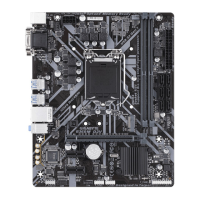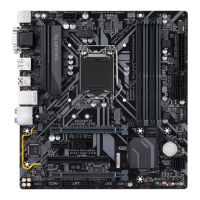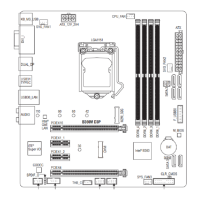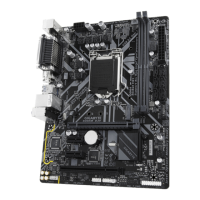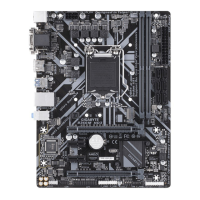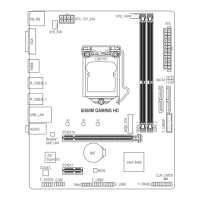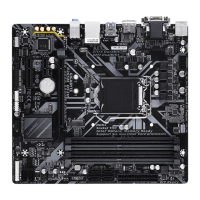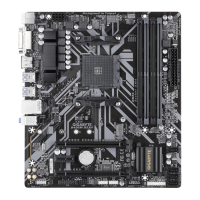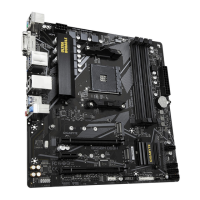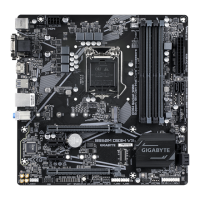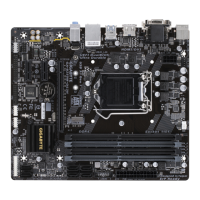Do you have a question about the Gigabyte B360M DS3H and is the answer not in the manual?
How to check the motherboard revision number for updates or technical information.
Lists all items included in the motherboard package.
Essential safety guidelines and procedures for installing hardware to prevent damage.
Detailed technical specifications of the motherboard components and features.
Step-by-step guide for installing the Central Processing Unit onto the motherboard socket.
Step-by-step guide for installing RAM modules into the motherboard slots.
Instructions for installing expansion cards like graphics or sound cards into PCIe slots.
Identifies and explains the function of ports located on the motherboard's rear panel.
Details the various pin headers and connectors found on the motherboard for internal components.
Describes the initial screen displayed during the computer's boot process.
Overview of the main BIOS interface and navigation controls.
Advanced settings for optimizing CPU and memory performance.
Displays motherboard model, BIOS version, and system date/time settings.
Configuration options related to boot devices, passwords, and system startup behavior.
Settings for onboard devices like LAN, audio, USB, and other integrated controllers.
Configuration options for the motherboard's chipset features, including graphics and audio.
Settings to control system power states, wake-up events, and energy saving features.
Options for saving BIOS changes, loading defaults, and exiting the setup utility.
Step-by-step guide for installing and configuring Intel® Optane™ memory modules.
Instructions for installing essential motherboard drivers and software from the provided disk.
Information on how to access GIGABYTE's online support portal for technical assistance.
How to check the motherboard revision number for updates or technical information.
Lists all items included in the motherboard package.
Essential safety guidelines and procedures for installing hardware to prevent damage.
Detailed technical specifications of the motherboard components and features.
Step-by-step guide for installing the Central Processing Unit onto the motherboard socket.
Step-by-step guide for installing RAM modules into the motherboard slots.
Instructions for installing expansion cards like graphics or sound cards into PCIe slots.
Identifies and explains the function of ports located on the motherboard's rear panel.
Details the various pin headers and connectors found on the motherboard for internal components.
Describes the initial screen displayed during the computer's boot process.
Overview of the main BIOS interface and navigation controls.
Advanced settings for optimizing CPU and memory performance.
Displays motherboard model, BIOS version, and system date/time settings.
Configuration options related to boot devices, passwords, and system startup behavior.
Settings for onboard devices like LAN, audio, USB, and other integrated controllers.
Configuration options for the motherboard's chipset features, including graphics and audio.
Settings to control system power states, wake-up events, and energy saving features.
Options for saving BIOS changes, loading defaults, and exiting the setup utility.
Step-by-step guide for installing and configuring Intel® Optane™ memory modules.
Instructions for installing essential motherboard drivers and software from the provided disk.
Information on how to access GIGABYTE's online support portal for technical assistance.
| Non-ECC | Yes |
|---|---|
| Memory channels | Dual-channel |
| Memory slots type | DIMM |
| Number of memory slots | 4 |
| Supported memory types | DDR4-SDRAM |
| Supported memory clock speeds | 2666, 2400, 2133 MHz |
| Supported memory module capacities | 8GB, 16GB |
| Processor socket | LGA 1151 (Socket H4) |
| Processor manufacturer | Intel |
| Compatible processor series | Intel® Celeron® |
| Maximum number of SMP processors | 1 |
| USB 2.0 connectors | 2 |
| Number of SATA connectors | 6 |
| USB 3.2 Gen 2 (3.1 Gen 2) connectors | 0 |
| HDMI version | 1.4 |
| USB connector type | USB Type-A |
| USB 2.0 ports quantity | USB 2.0 ports have a data transmission speed of 480 Mbps, and are backwards compatible with USB 1.1 ports. You can connect all kinds of peripheral devices to them. |
| Ethernet interface type | Fast Ethernet, Gigabit Ethernet |
| Cooling type | Passive |
| Component for | PC |
| Power source type | ATX |
| Motherboard chipset | Intel B360 Express |
| PC health monitoring | CPU, FAN, LED, Temperature, Voltage |
| Audio output channels | 7.1 channels |
| Motherboard form factor | micro ATX |
| Windows operating systems supported | Windows 10 |
| Graphics card | HD Graphics |
| Maximum resolution | 4096 x 2160 pixels |
| Maximum graphics card memory | 1024 MB |
| BIOS type | UEFI AMI |
| Depth | 226 mm |
|---|---|
| Width | 205 mm |
